Saffron, the red gold in Mediterranean cuisine

CONTENT:
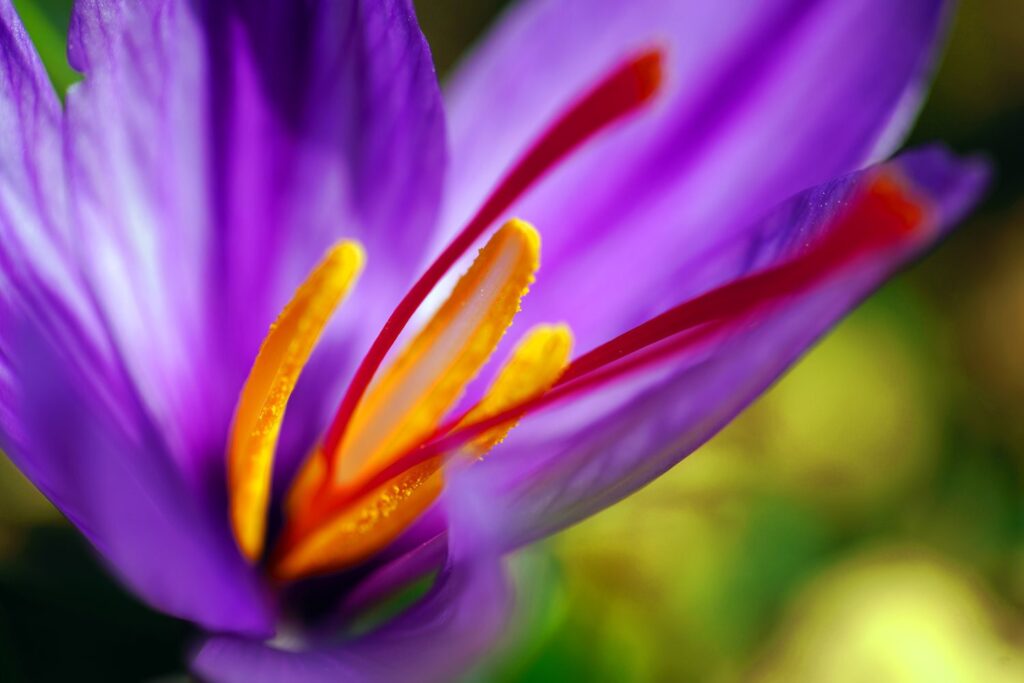
Introduction:
Saffron is known as one of the most expensive spices in the world, often referred to as red gold in the culinary sector. In this article, I provide a detailed overview of the various uses of saffron in cooking, its cultural relevance, and practical advice for its use.
What is saffron?
Saffron, which comes from the pistils of the Crocus sativus plant, plays a crucial role in various culinary traditions around the world, especially Mediterranean cuisine. This text aims to provide an in-depth understanding of how saffron can be used to enrich dishes, while providing background information on its origins and cultural value.
- Grow and Bloom:
Crocus sativus blooms once a year, usually in the fall. The flowers grow directly from the bulbs, which are underground.
Each flower produces three pistils, which contain the precious saffron.
2. Harvest:
The harvest of saffron is labor intensive and must be done by hand, often at dawn or in the early morning hours. This is because the flowers open at sunrise and the pistils must be picked quickly to maintain their optimal quality and aroma.
The workers carefully collect the delicate purple flowers, usually in baskets.
3. Extraction:
After harvest, the pistils (the red styles and stigmas) are carefully separated from the flowers by hand. This is a precise and time-consuming job.
Because only a small amount of saffron comes from each flower (three pistils per flower), it takes thousands of flowers to produce just one pound of saffron.
- To dry:
After extraction, the pistils are dried. This can be done in the sun, in a drying oven, or over a fire. The drying process is crucial for developing the deep flavor, color and aroma of the saffron.
Well-dried saffron is dark red and slightly curved at the end, and should have a strong scent and intense color.
- Storage:
After drying, saffron is stored in airtight containers to maintain its quality. It should be protected from light and moisture to maximize shelf life.
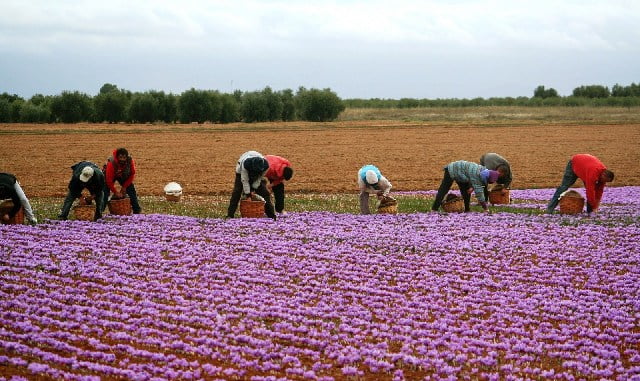
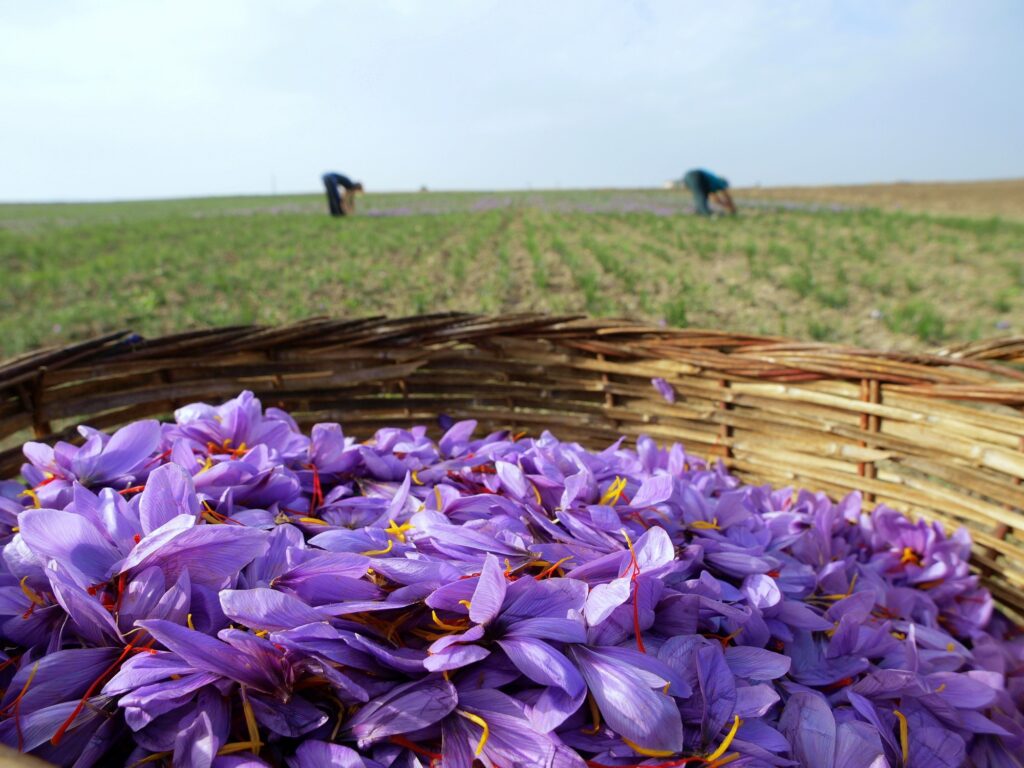
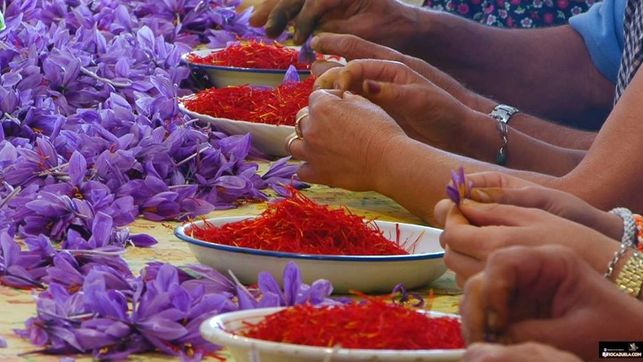
History and origins:
Known for its distinctive color, taste and aroma, saffron indeed has a rich and fascinating history dating back to ancient times. Its use extends across cultures and continents, from ancient Persia to Greece, Rome, and beyond into the Arab and Mediterranean worlds.
Ancient:
The earliest mentions of saffron date back to the 3rd millennium BCE. in the Persian region, where it was used not only as a spice but also as a component in perfumes and as a ritual offering.
In the Minoan civilization of Crete, frescoes depicting saffron have been found, indicating its use in dyes and possibly medicinal purposes.
Greeks and Romans:
The Greeks used saffron in their public baths, as a perfume, and even as an aphrodisiac. It also became a common ingredient in Greek cooking and medicine.
The Romans adopted many of these customs and brought saffron further into Europe. They valued it highly for its healing properties, especially in treating wounds and purifying blood.
Middle Ages:
During the Middle Ages, saffron was highly sought after in Europe, not only as a spice but also as a substance for dyeing royal clothing and as a medicinal herb. It became so valuable that it was sometimes worth its weight in gold.
During this period, saffron was also introduced to Spain by the Arabs, where it became an essential ingredient in local cuisine, especially in dishes such as paella.
Tiempos modernos:
The use of saffron spread around the world, but the main production areas remained in countries such as Iran, Greece, Morocco, and Spain. Iran is today the largest producer of saffron.
Today, saffron is not only used in cooking but also remains an important element in cultural and religious ceremonies in different cultures.
Culinary uses of saffron:
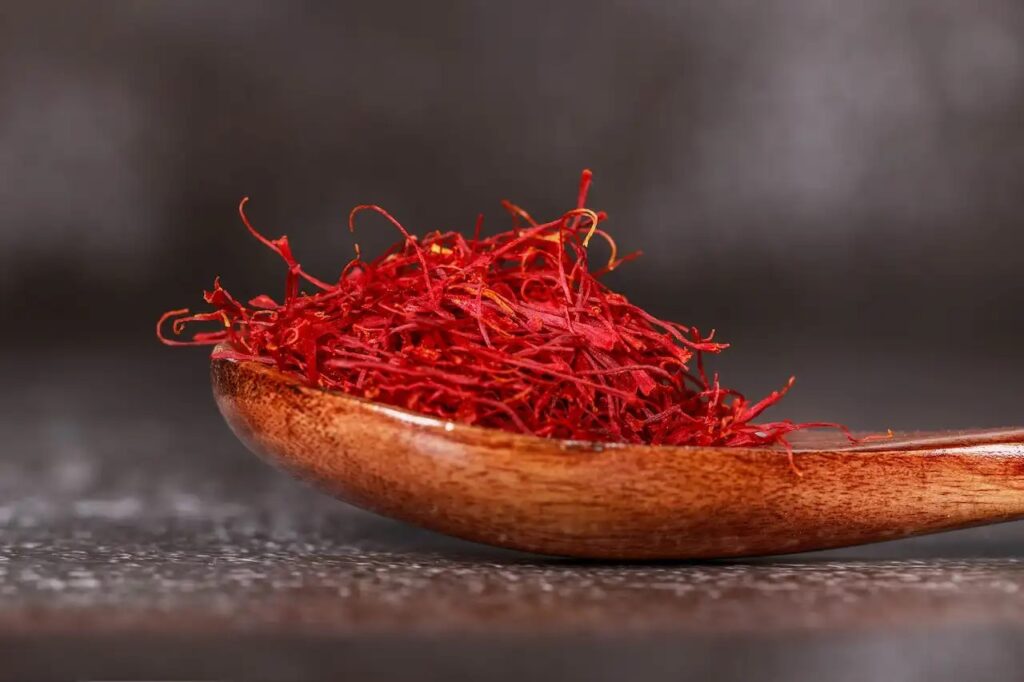
1. Spanish Paella:
- Saffron is an essential ingredient in authentic Spanish paella, where together with colorante it gives the rice its characteristic golden yellow color and subtle taste.
- Usage tip: Let the saffron threads soak in warm water or stock for a few minutes before adding them to the paella. This helps to release their flavor and color.
2. French Bouillabaisse:
- In this traditional Provencal fish soup, saffron provides a unique taste and beautiful color.
- Usage tip: Add saffron to the stock and let it cook to integrate the flavors. The saffron will add a depth that takes the dish to the next level.
3. Iranian saffron rice:
- In Iran, saffron is used to perfume rice, resulting in a beautifully colored and fragrant side dish.
- Usage tip: Dissolve saffron in hot water and add it to the almost cooked rice so that the aromas and colors can spread nicely.
4. Risotto italiano a la milanesa:
- Saffron is the secret ingredient that gives this risotto its beautiful color and rich taste.
- Usage tip: Add saffron to the stock you use to cook the risotto so that every grain of rice can absorb the flavor and color.
5. Moroccan Tagines:
- In Moroccan dishes, saffron is often used in tagines, where it gives meat, vegetables and rice a wonderful taste and aroma.
- Usage tip: Combine saffron with other spices such as ginger, cinnamon and turmeric to create a rich and complex flavor.
6. Desserts and Sweets:
- Saffron can also be used in desserts, such as Spanish flan, Iranian saffron ice cream, or Indian saffron pudding (kheer).
- Usage tip: A little bit of saffron is enough to give a special taste and color to sweet dishes.
Storage and shelf life:
Store saffron in a cool, dry place, away from light and moisture. In the right conditions, saffron can last for several years.
By following these tips and recipe ideas, you can bring out the authentic flavor of saffron and add an extra dimension to your dishes.
Health benefits:
1. Antioxidant properties:
Saffron contains powerful antioxidants that help neutralize harmful free radicals in the body. This can promote overall health and reduce the risk of various diseases.
The antioxidants in saffron, such as crocin, can also protect the skin against UV rays and premature aging.
2. Stimulation of good mood:
Several studies suggest that saffron may help improve mood and may be effective in reducing symptoms of depression. This is said to be due to the influence of saffron on neurotransmitters such as serotonin in the brain.
Saffron is sometimes called ‘the sunshine spice’ because of its potential to promote lighter moods.
3. Mental health support:
In addition to its positive effect on mood, there is evidence that saffron can help improve cognitive functions and reduce symptoms of Alzheimer’s.
4. Potential anticancer properties:
Some research suggests that the antioxidants in saffron may have anticancer properties by inducing cell death in certain cancer cells.
5. Stimulates digestion:
Saffron can aid in digestion by stimulating the secretion of digestive juices and can help relieve stomach complaints such as gas and bloating.
6. Heart health:
There is some evidence that saffron may contribute to heart health by improving blood circulation and lowering blood pressure and cholesterol levels.
7. Support for menstruation and PMS:
Saffron is also used to relieve symptoms of premenstrual syndrome (PMS) and menstrual pain.
Although saffron offers great health potential, it is important to remember that it should be viewed as a supplement and not a replacement for a balanced diet or medical treatment. It is also recommended to consume saffron in moderate amounts as high doses can be toxic. As with any supplement or herb, it is advisable to consult a health professional before beginning to regularly use saffron for medicinal purposes.
How to store saffron:
- Dry and Dark: Store saffron in a dry, dark place. Light and moisture can affect the quality of saffron, so it is best to store it in an airtight container, away from direct sunlight.
- Airtight Containers: Use an airtight container to protect the saffron from moisture and aroma loss. Glass or metal is ideal because these materials do not absorb odors.
- Temperature: Store saffron at a stable, cool room temperature. Extreme temperature changes can affect the delicate flavor compounds in saffron.
How to use saffron:
- Pre-soaking: To maximize the flavor of saffron, it is advisable to pre-soak the threads in a warm liquid such as water, stock, or milk. This process helps to release the flavor compounds. A general guideline is to pre-soak saffron for at least 20 to 30 minutes, but longer (up to a few hours) can release even more flavor.
- Dosage: Saffron is very powerful, so a little goes a long way. It is advisable to start with a pinch or a few threads and add to taste. Too much saffron can make a dish bitter.
- Pulverizing: Another method of using saffron is to first finely grind the threads into powder, possibly with a pinch of salt or sugar to make grinding easier. This method makes it easier to distribute the saffron evenly throughout the dish.
- Add during cooking: Add saffron early in the cooking process to allow it to fully release its aroma and color. In some dishes, adding saffron at the beginning can help all the ingredients absorb the flavor.
- Dishes compatibility: Saffron is versatile and can be used in many dishes, from rice dishes and soups to stews and desserts. Experiment with saffron in different recipes to see how it enhances the flavor of different ingredients.
Do-it-yourself Recipe:
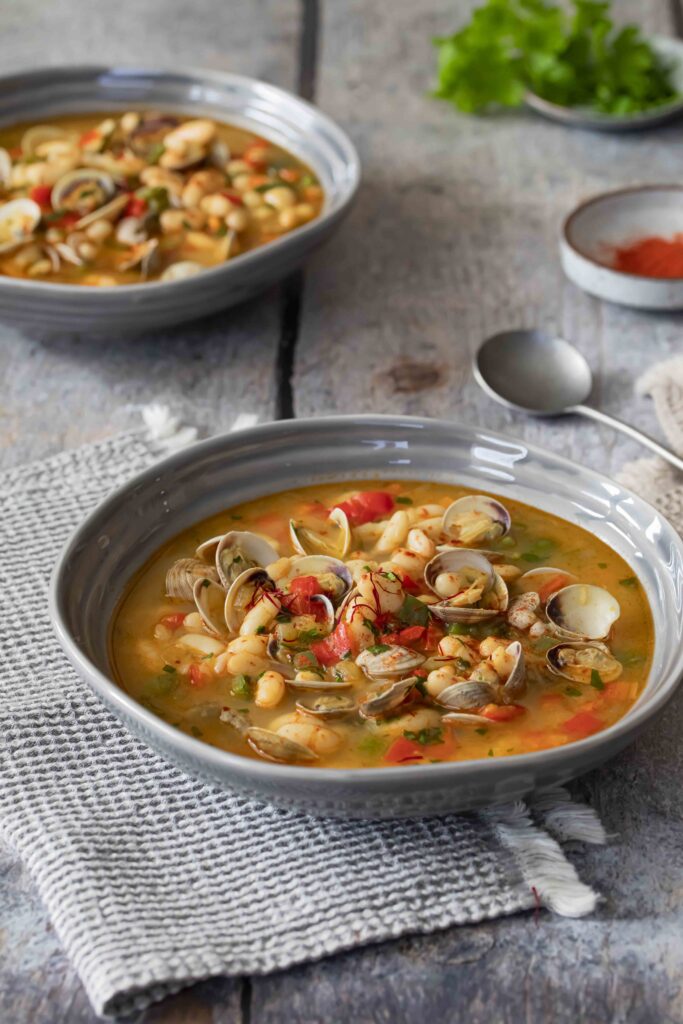
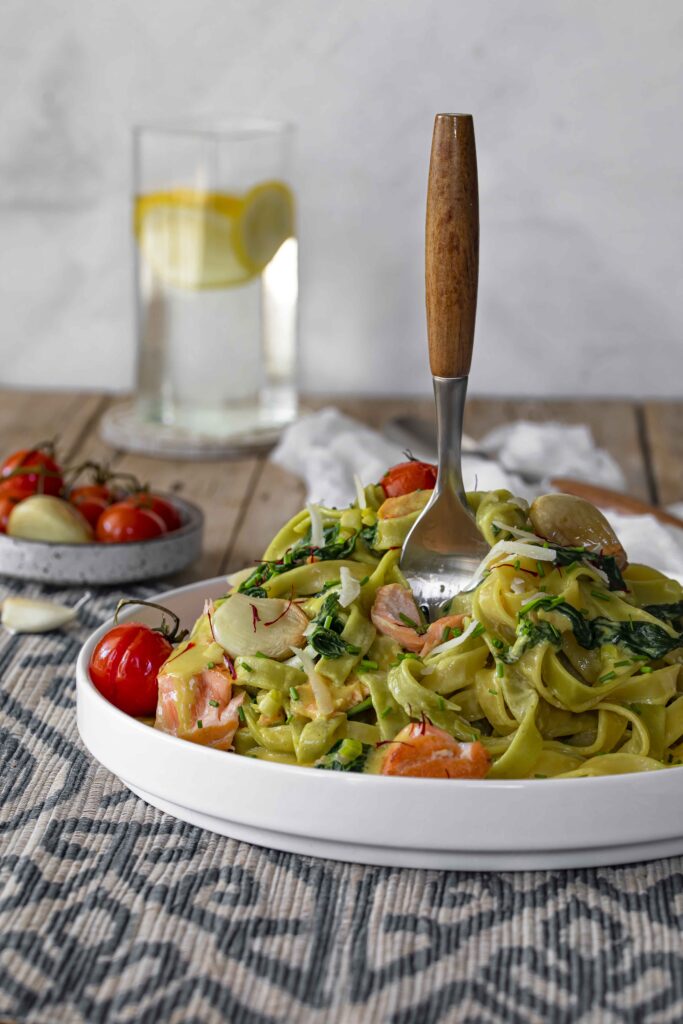
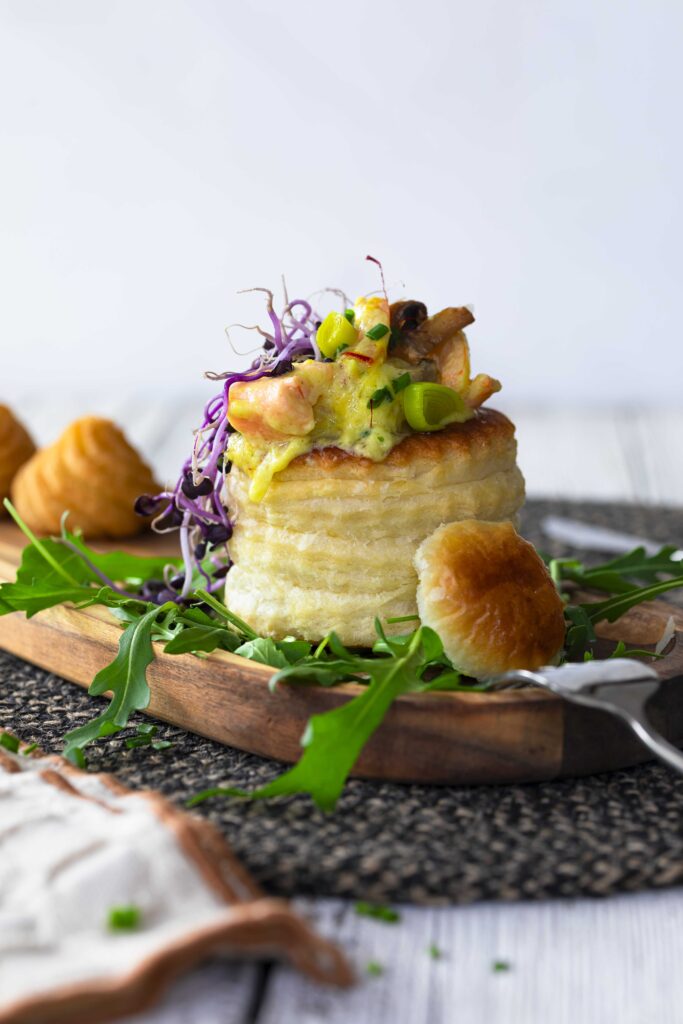
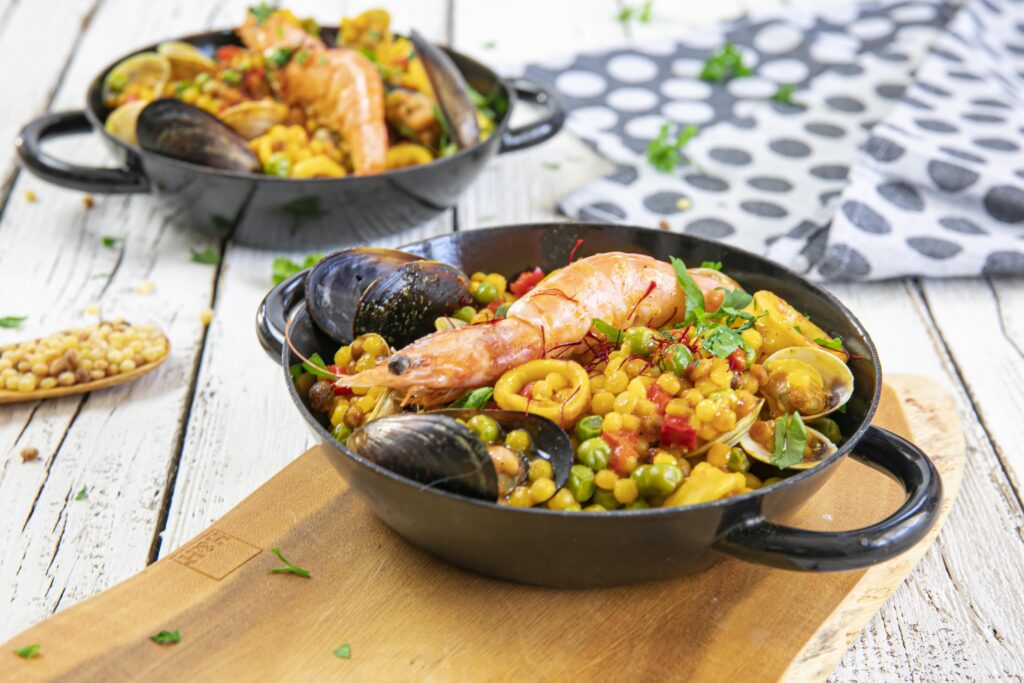
Would you also like to get started with saffron? Then I have some dishes for you here:
What is your experience with saffron? Have you already made delicious dishes yourself?
Feel free to share a photo of your culinary creation here at the bottom of the post.

Download my E-book
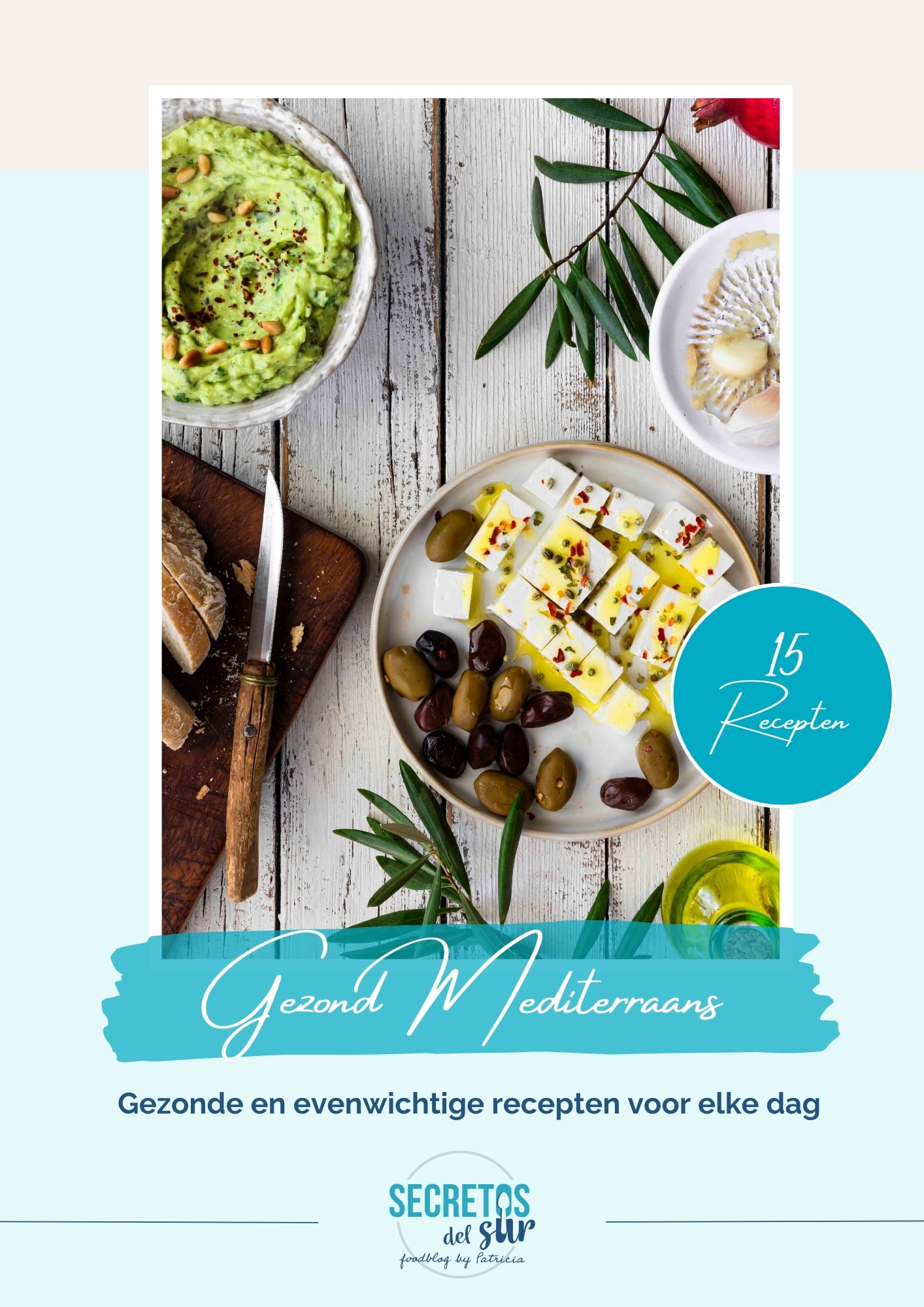
This booklet is my culinary ode to the Mediterranean cuisine; a collection of flavors and aromas that embody my passion for cooking, intended to inspire or enrich both the experienced chef and the home cook with the simplicity and purity of Mediterranean tastes. Easy recipes, accessible to everyone, and with a broad palette of flavors.
Order here
Foodblog
by Patricia
I am Patricia, energetic 40'er, architect, business manager and food blogger. Living in Andalusia but from Flanders - Belgium. Mother of 2 active and creative kids who, together with my husband Geert, form the tasting team of the first order!
Cooking has become a passion. Everything starts with devising an original recipe and that’s when my love for food photography & styling comes across…
In my blog you will get to know my healthy Mediterranean fusion cuisine!
Buen provecho!
Nieuwsbrief
Subscribe to our newsletter and stay informed about the latest news and amazing recipes.




Leave a Reply